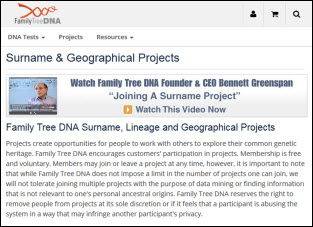Those Y lines are handy!
Reader Sharin is stumped in one line of her ancestry because of an undocumented father.
The story of the child’s mother is a great one — all over the town records as the local leaders tried to chase down those who’d be legally responsible for the support of three children all born out of wedlock. There are fathers identified for two female children, a conviction for fornication, and other great court records.
But… alas… no-one named as the father of the last child.
The one Sharin hopes is her male ancestor.
So, she asks, could there be any chance of finding Y-DNA test results for a surname with sourced paper trails?
And the answer is …
Yep.
There very well may be just what Sharin is looking for.
And it’s in a resource that’s among the oldest, most venerable, most useful and yet now most underutilized DNA resources around: the YDNA surname projects at Family Tree DNA.
As explained on the ISOGG Wiki:
Surname DNA projects are genetic genealogy projects which use genealogical DNA tests to trace male lineages. Because surnames are passed down from father to son in many cultures, and the Y chromosome is passed from father to son with a predictable rate of mutation, people with the same surname can use genealogical DNA testing to determine if they share a genealogical common ancestor.
When two males share a surname, a test of their Y-chromosome markers will determine either that they are not related, or that they are related. If they are related, the number of markers tested and the number of matches at those markers determines the range of generations until their most recent common ancestor (MRCA). If the two tests match on 37/37 markers, there is a 50% probability that the MRCA was fewer than five generations ago and a 90% probability that the MRCA was fewer than 17 generations ago.1
These days, because Family Tree DNA is the only game in town for YDNA testing, it’s the big repository for all kinds of YDNA info and the home of the projects. There’s more information there on the surname projects at its Surname & Geographical Projects page. At last count, there were nearly 10,000 surname projects at Family Tree DNA (for YDNA, mtDNA or both) run by volunteer project administrators.2
 You can search for surnames from the Surname & Geographical Projects page or navigate through the alphabetical listings.
You can search for surnames from the Surname & Geographical Projects page or navigate through the alphabetical listings.
And you can also find at least some FTDNA surname projects through the alphabetical project lists on the World Families Network website, though the links back to Family Tree DNA don’t work there, and not every FTDNA surname project is listed there at all.
How much information will be available for any given surname depends on a whole lot of variables, with the biggest one being how many members the project has and how active they are. Some surname projects have fewer than 10 members, while others easily exceed 1,000 testers. For my Baker line, for example, there are 1,152 testers, most of whom have indicated five or six generations of Baker male ancestors, and a marvelous publicly-accessible results page — http://www.bakerdna.net/ — grouping the testers by ancestral line. For my Buchanan line, by contrast, in the results of nearly 400 tested, only the farthest-back male ancestor is shown.
The second big variable is whether the project has a publicly-accessible results page — and not every project with a publicly-accessible results page will show up on the World Families Network website. Only the projects with results pages hosted on World Families Network appear in that list. The Baker project, for example, is run independently and so doesn’t show up there. The same is true of the Clan Donnachaidh project (which includes my Robertsons) — its 1500+ member website is at http://www.clandonnachaidhdna.org/.
Some projects require that you join the project before getting access to the results page, but every project has a project administrator who can be contacted for more information. Yes, some are more active than others of course, and some more knowledgeable than others. All, however, can be resources at least to contact others in the male line who may have more information.
If there isn’t a surname project for the particular name you’re interested in, look for a project that covers the geographic region or the specific haplogroup you’re in. That may at least narrow down your search — and put you in touch with enough people sharing your research interest to start a surname project yourself.
These projects are great resources, and shouldn’t be forgotten or overlooked in our enthusiasm for chasing cousins and those blasted ethnicity estimates that are so frustrating.3
SOURCES
- ISOGG Wiki (http://www.isogg.org/wiki), “Surname DNA projects,” rev. 3 Feb 2017. ↩
- See Surname & Geographical Projects, Family Tree DNA (https://www.familytreedna.com/ : accessed 4 Feb 2018). ↩
- See e.g. Judy G. Russell, “Still not soup,” The Legal Genealogist, posted 16 Apr 2017 (https://www.legalgenealogist.com/blog : accessed 4 Feb 2018). ↩



A number of Irish and Scottish clans have started surname projects, which in some cases appear to be validating some of the traditional oral histories going back to the dark ages. The MacGregors have a special interest in the potential this research holds for restoring identities lost to many MacGregor families who, after being famously outlawed, spent the better part of a century, during which they were persecuted, and even killed, for simply being known as MacGregors, in hiding under a number of different aliases. ( http://www.clangregor.com )